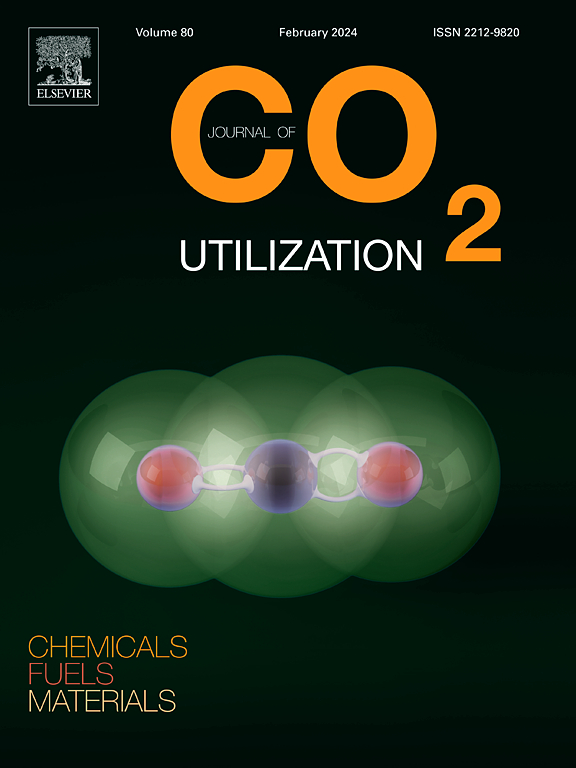Oxalamide-derived ionic polymer/carbon nanotube composites: Highly active heterogeneous catalyst for promoting cycloaddition of carbon dioxide to epoxides
IF 7.2
2区 工程技术
Q1 CHEMISTRY, MULTIDISCIPLINARY
引用次数: 0
Abstract
Ionic polymers functionalized with hydrogen bond donors (HBDs) exhibit immense potential in the green chemical fixation of carbon dioxide (CO2); however, achieving high catalytic activity remains a significant challenge. In this study, we synthesized oxalamide-based ionic polymers and their composites with carbon nanotubes using a straightforward ball-milling method. The incorporation of oxalamide notably enhanced the catalytic activity of the ionic polymers by activating the C-O bond of the epoxide via HBD interaction. Furthermore, compositing with carbon nanotubes enhanced the catalytic performance of the composite materials via improving the accessibility of active sites. As a result, the optimized composite catalyst, P(PyOA-BBr3)@CNT-3, demonstrated exceptional catalytic efficiency in the cycloaddition reaction between CO2 and epichlorohydrin, achieving an outstanding initial turnover frequency (TOF) of 1360 h−1 and a 68 % yield of epichlorohydrin carbonate at 140 °C. This makes our solid organocatalyst one of the most efficient metal-free solid catalytic systems reported to date. Moreover, P(PyOA-BBr3)@CNT-3 exhibited good substrate compatibility and could be easily recycled and used for at least six cycles. This study not only introduces an efficient HBD for designing bifunctional catalysts, but also presents a feasible and environmentally friendly approach for constructing highly active ionic polymer-based composite catalysts for CO2 fixation.
草酰胺衍生离子聚合物/碳纳米管复合材料:促进二氧化碳与环氧化物环化反应的高活性异相催化剂
氢键给体功能化的离子聚合物在二氧化碳的绿色化学固定中表现出巨大的潜力;然而,实现高催化活性仍然是一个重大挑战。在这项研究中,我们用直接的球磨法合成了草酰胺基离子聚合物及其与碳纳米管的复合材料。草酰胺的掺入通过HBD相互作用激活环氧化物的C-O键,显著提高了离子聚合物的催化活性。此外,碳纳米管复合材料通过提高活性位点的可及性来提高复合材料的催化性能。结果表明,优化后的复合催化剂P(PyOA-BBr3)@CNT-3在CO2与环氧氯丙烷的环加成反应中表现出优异的催化效率,在140℃下,初始转换频率(TOF)为1360 h−1,环氧氯丙烷的收率为68 %。这使得我们的固体有机催化剂是迄今为止报道的最有效的无金属固体催化系统之一。此外,P(PyOA-BBr3)@CNT-3表现出良好的底物相容性,可以很容易地回收和使用至少6次循环。本研究不仅为设计双功能催化剂提供了高效的HBD方法,而且为构建高活性离子聚合物基复合CO2固定催化剂提供了一种可行且环保的方法。
本文章由计算机程序翻译,如有差异,请以英文原文为准。
求助全文
约1分钟内获得全文
求助全文
来源期刊

Journal of CO2 Utilization
CHEMISTRY, MULTIDISCIPLINARY-ENGINEERING, CHEMICAL
CiteScore
13.90
自引率
10.40%
发文量
406
审稿时长
2.8 months
期刊介绍:
The Journal of CO2 Utilization offers a single, multi-disciplinary, scholarly platform for the exchange of novel research in the field of CO2 re-use for scientists and engineers in chemicals, fuels and materials.
The emphasis is on the dissemination of leading-edge research from basic science to the development of new processes, technologies and applications.
The Journal of CO2 Utilization publishes original peer-reviewed research papers, reviews, and short communications, including experimental and theoretical work, and analytical models and simulations.
 求助内容:
求助内容: 应助结果提醒方式:
应助结果提醒方式:


